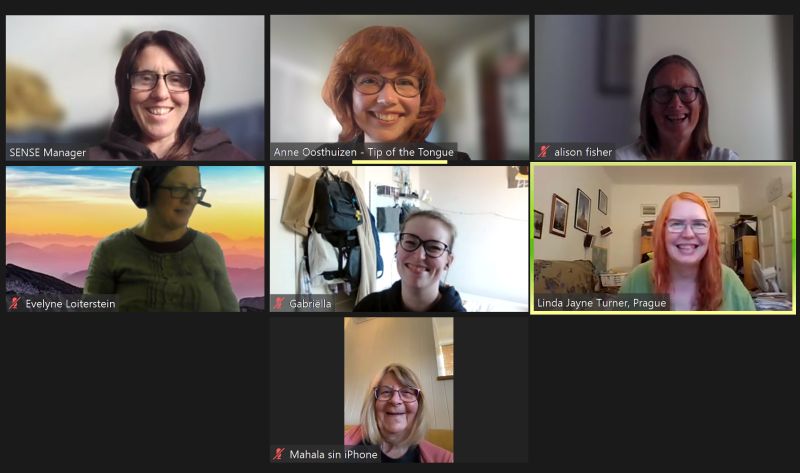At the SENSE Starters SIG on 4 July 2024, Anne Oosthuizen (Tip of the Tongue) spoke about personal branding, a subject she knows well and has previously been invited to talk about by both Leiden University and NGTV. Anne is an English-Dutch (and sometimes Dutch-English) translator, editor and copywriter with a BA in English Language and Culture from the University of Amsterdam and the University of Otago in New Zealand, and an MA in Translation Studies from Leiden University. As well as translating literary and non-fiction prose, she also specializes in poetry and song translation. This Starter SIG was based on a talk she gave at the SENSE 2021 PPD, which I enjoyed, and so I eagerly anticipated this session.
Anne started by asking us what makes up our personal brand. Her view is that it’s our company identity and marketing strategy. She advised us to begin by questioning who we are professionally, who our clients – or potential clients – are, and where we want to take our company in the future. When considering this last question, in other words, what success looks like for us personally, we should think about different time scales such as three, six or twelve months, or – more long term – five years, for example.
Another question to ask ourselves is what we excel at and what distinguishes us from our colleagues. When considering who our clients are, we should also take into account what they don’t want as well as what they do want and what we can do for them. A business one-liner can come in handy here. Anne’s proposed one-liner was: “I help clients in the creative sector transpose their artistic vision to the Dutch culture” and she encouraged us to think about our own.
One important decision relating to company identity is whether to use our own name, which is perhaps more personality driven and closely connected to the image of a freelancer (solo entrepreneur or ZZP’er in Dutch), or whether to use a different company name. Anne conducted a quick poll and we discussed this afterwards. The second option gives more scope for adding extra people and growing the business.
There are various aspects to consider when creating a company identity such as colour scheme, font or fonts, logo and mood. Anne gave us some handy links to help with our visual identity:
- Logos: https://hatchful.shopify.com/
- Pictures: https://unsplash.com/
- Graphics: https://www.canva.com/
Online marketing comprises of social media such as LinkedIn, Facebook, X, Instagram, TikTok and YouTube as well as a company domain: website and perhaps any blogs or podcasts. Your website works for you around the clock but, as Anne pointed out, you need to keep an eye on the loading speed and make sure everything is in the right place, bearing in mind that most people tend to search on their phone nowadays. And, of course, it has to be regularly updated. Although a lot of our lives are online nowadays, Anne reminded us that there is also still a place for offline marketing. You can still hand out business cards at events, use personalized stationery, flyers, (seasonal) greeting cards, wearable merchandise and, possibly, edible merch. Anne stressed the importance of letting your personality shine through in all aspects of your brand and of being authentic while also paying attention to your intended target audience. She ended her talk by advising us to be consistent and not to lose sight of our marketing strategies.
Following on from Anne’s presentation, we spoke about the use of edible merch for branding. Anne gave the example of Italian financial translator Martina Abagnale whose logo is a lemon – and her business card comes with a lemon sweet. An idea I got from a hotel I stayed in is to stick a small chocolate on a business card, something that might work for Anne – playing on the idea of melting on the tip of the tongue.
As mentioned, we also talked more about the naming of a company: the pros and cons of using your own name versus a company name. This depends partly on the type of client – academic versus corporate – and partly on when you set up the business. For instance, one participant who has been in business for many years used her own name whereas she said it is more usual to have a different name now and that’s what she would do if she were setting up a new company today. Besides Anne’s Tip of the Tongue, we had some other great names among the group of attendees: Bex Checks (Becky Tomas), Aegis Translations (Tyler Langendorfer) and Selfish Warrior (Alison Fisher), for instance. Since I tend to have a personal relationship with the authors I work with, I use my own name for my academic editing services. My logo includes a sunflower (thank you to Alex Went at Websites Wanted for that) and, for my personal branding, I use sunflower icons in chats in my co-working group and coffee cups with sunflowers in Zoom meetings, etc.
Another point we discussed was whether to have an Instagram account for promoting our businesses as well as a LinkedIn one. It might be good, for example, if your clients include musicians as in Anne’s case. Anne recommended we check out marketing legend Martina Eco, and Alison sang the praises of Instagram expert Elise Darma.
Anne’s subsequent LinkedIn post about the session also prompted an online discussion: Samuel Murray made some excellent points, including stressing the importance of professional associations and of word of mouth for referrals.
This was a really enjoyable evening session with a small but very supportive group and a nice, relaxed atmosphere. The ensuing discussion was lively and could have continued for much longer. I had high expectations and was certainly not disappointed. A big thank you to Anne Oosthuizen and to Becky Thomas for moderating the session and sharing Anne’s slides with the participants afterwards. It has definitely given me some good ideas, some of which I have already implemented, trying to incorporate my logo into all aspects of my personal branding.
Blog post edited by Robin Finesilver

